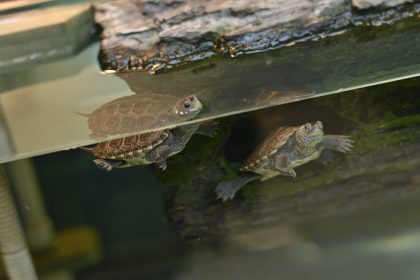
Terrapins from Poplar Island are getting a “head start” on life!
Maryland Environmental Service, on behalf of the Maryland Department of Transportation Maryland Port Administration, works with local organizations and schools to place hatchling terrapins in classrooms. The juvenile turtles from the Paul S. Sarbanes Ecosystem Restoration Project at Poplar Island live in classrooms from fall through the following spring.
Students provide all care to the terrapins. They collect growth data, observe behavior, learn care and husbandry protocol, and research the natural history of our state reptile. Head starting allows the hatchlings to grow to the size of a 2-3 year old wild juvenile terrapin in just nine months.
After caring for the hatchlings, students bring the terrapins back to Poplar Island where they are released to the Bay. This hands-on learning experience engages students to take action and better understand the restoration of the Chesapeake Bay.
Poplar terrapins are being raised and released through several programs:
- Maryland Environmental Service facilitates the Terrapin Education and Research Partnership (TERP) program for some Eastern Shore schools.
- Arlington Echo’s Terrapin Connection program accommodates Anne Arundel County Public Schools.
- The National Aquarium provides terrapins to 30 schools.
All three programs are part of an ongoing research study conducted by Dr. Willem Roosenburg at Poplar Island. Dr. Roosenburg is a national authority on the diamondback terrapin and associate professor of biology at Ohio University.
Poplar Island is a one-of-a-kind 1,140-acre restoration project off Tilghman Island in the Chesapeake Bay. Poplar Island, which had eroded to five acres by 1993, is being restored to its 1847 footprint using sediment dredged from the shipping channels approaching the Port of Baltimore. A lack of land predators, undisturbed sandy shorelines, and a variety of habitat types make Poplar an ideal terrapin nesting site.
Before the head start terrapins are released back on the beaches of Poplar Island, they are implanted with a Passive Integrated Transponder (PIT) tag. If these terrapins are ever recaptured, they can be scanned and identified. Dr. Roosenburg’s study is trying to answer the question of whether having a “head start” really gives these terrapins a higher chance of surviving in the wild.
Through this program, students are playing an important role in relevant, cutting-edge research focused on the conservation of the species. The combination of scientific applications, hands-on involvement, and the emotional attachment to the terrapins provides a unique opportunity to inspire a meaningful connection with the Chesapeake Bay.


